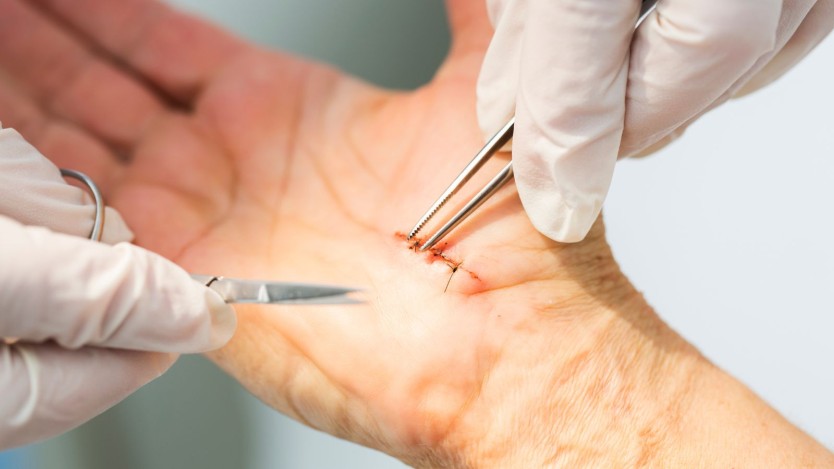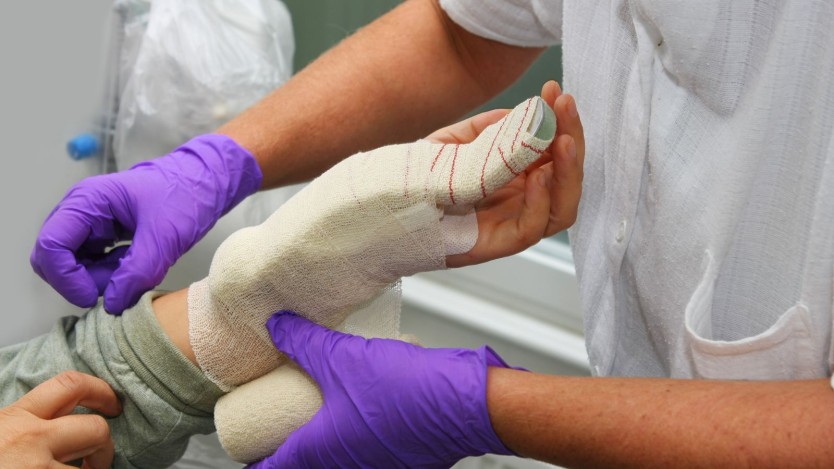What treatments are available for carpal tunnel syndrome?

- What is carpal tunnel syndrome?
- Diagnosis
- Non-pharmacological treatment
- Pharmacological treatment
- Surgical treatment
- Postoperative period after carpal tunnel surgery
- Bibliography
- Frequent Questions
What is carpal tunnel syndrome?
Carpal tunnel syndrome is a very common condition that occurs because of excessive pressure on the median nerve.
This nerve, located in the wrist, provides sensation and movement to parts of the hand. The median nerve from the forearm to the hand is compressed at the wrist or gets stuck in the tube formed by the carpal bone.
The median nerve controls sensation in the front of the fingers (except the little finger) and the impulse of some small muscles in the hand, which causes the fingers and thumb to move.

Do you need carpal tunnel surgery?
Request a free and immediate appointment with our specialists in Traumatology
Diagnosis
If carpal tunnel syndrome is clinically suspected, the sensitivity and strength of the hands and the movements that trigger the symptoms should be checked.

During the assessment, the doctor will talk to you about your general health and medical history and ask you about your symptoms. He or she will carefully examine your hands and wrists and perform some physical exams:
- Light pressure along the median nerve on the inside of the wrist to see if it causes numbness or tingling in the fingers.
- Bend and hold both wrists in this position to assess if the hand is numb or tingling.
- Check the sensitivity of the fingertips and hands. Gently touch them with a special instrument, while closing your eyes.
- Check for weakness of the muscles around the base of the thumb.
- Look for atrophy of the muscles around the base of the thumb. In severe cases, these muscles will become significantly smaller.
Some doctors recommend an X-ray examination of the affected wrist to rule out other causes of pain in the area, such as arthritis or fractures. However, X-rays are not usually effective in diagnosing carpal tunnel syndrome.
Non-pharmacological treatment
Treatment of carpal tunnel syndrome aims to reduce pressure on the median nerve and prevent irreversible damage to the nerve over time. Therefore, once diagnosed, it should be treated as soon as possible.

To treat Carpal Tunnel Syndrome, it is not always necessary to resort to surgery. If the condition is diagnosed early, there are non-surgical treatments that can help relieve pain, as well as symptoms of tingling and numbness:
- Wrist cast
- Anti-inflammatory drugs
- Corticosteroids
However, when non-surgical therapy has no effect, surgery is the usual medical recommendation.
Pharmacological treatment
On the other hand, in some cases, corticosteroid infiltration, with or without local anaesthetics, is used in the carpal tunnel. This type of treatment is recommended to be injected a maximum of 3 times at an interval of 2-3 months.
Corticosteroid infiltration can relieve symptoms and improve nerve conduction, but is not always effective. Corticosteroids can also be applied by electrical current (iontophoresis).
In cases where the severity of the disease affects the patient's quality of life and non-surgical treatments have had no effect, the specialist will recommend surgery as the only effective solution for carpal tunnel syndrome.
Surgical treatment
Carpal tunnel syndrome surgery can be performed using two different techniques. Although both use the same anaesthesia and both have very good results, the use of one or the other will depend on which technique the surgeon feels more comfortable with and considers that the operation will be successful.

We explain the step-by-step instructions for each of them:
Mini-incision technique
- The surgeon makes an incision on the inside of the wrist to gain access to the carpal tunnel area.
- Through this incision, the surgeon will insert a probe into the fatty area of the carpal tunnel and relieve the pressure causing the symptoms.
- Once the pressure is relieved, the surgeon removes the probe, sutures the skin and places a compression bandage immobilising the wrist.
Agee endoscopic technique
- After anaesthesia takes effect, the specialist makes a 2 cm incision in the wrist crease.
- He inserts dilators into the wrist, ensuring their placement by palpating the wrist.
- He will then insert a pistol-shaped instrument with a fibre-optic camera and a folding cutting blade to relieve the pressure on the nerve. All of this is viewed from a monitor to which the camera is connected.
- Once the pressure causing the symptoms has been relieved, the specialist will suture the incision and apply a compressive bandage in the same way as for the mini-incision technique, thus completing the surgery.
In both cases, it is an outpatient surgery, lasting about 30-90 minutes.
As this is an outpatient surgery, you will be able to return home, and after discharge, it can take approximately 8 weeks to reach full recovery. After this time, you will be able to resume your daily activities as before the syndrome.
The risks or complications of this surgery are very low. In less than 1% of cases, there is a problem of damaging nerves, blood vessels or tendons. However, there may be some tenderness in the scar area.
Postoperative period after carpal tunnel surgery
After surgery, it is advisable to undergo rehabilitation sessions and to take precise care of the scars so that they adhere to all flat surfaces and flexor tendons.
Generally, your doctor will encourage you to use your hands after the ligament has healed. In this way, you will gradually return to normal hand use, but initially excessive hand movements or extreme wrist postures.
Swelling or weakness after surgery may take weeks or months to go away. In very rare cases, when symptoms are very severe, they may not disappear completely after surgery.
Although the amount of time off work varies from patient to patient, the estimated time off work is 2 to 3 weeks. It also depends on whether the operating hand is dominant and on the patient's activity at work.

Do you need carpal tunnel surgery?
Request a free and immediate appointment with our specialists in Traumatology
Bibliography
- Mayo Clinic. (2020, 5 mayo). Síndrome del túnel carpiano - Diagnóstico y tratamiento - Mayo Clinic. https://www.mayoclinic.org/es-es/diseases-conditions/carpal-tunnel-syndrome/diagnosis-treatment/drc-20355608
- (s. f.). Síndrome del túnel carpiano. Recuperado 19 de noviembre de 2020, de https://medlineplus.gov/spanish/ency/article/000433.htm
Medical disclaimer: All the published content in Operarme is intended to disseminate reliable medical information to the general public, and is reviewed by healthcare professionals. In any case should this information be used to perform a diagnosis, indicate a treatment, or replace the medical assessment of a professional in a face to face consultation. Find more information in the links below:
Frequent Questions
-
When can I exercise after carpal tunnel surgery?
As it is an outpatient surgery, you will not need to stay in hospital, so you can go home the same day of the operation.
As for full recovery, it will take you no more than 8 weeks to be able to return to your daily activities, just as you did before contracting carpal tunnel syndrome. Read more
-
Can carpal tunnel recovery be achieved without surgery?
In some cases, where carpal tunnel syndrome is diagnosed early, it is possible to use non-surgical treatment with wrist braces and drugs to relieve pain and other symptoms of the syndrome. Read more
-
How is carpal tunnel surgery performed?
The surgery consists of cutting the transverse carpal ligament, increasing the volume of the tube and reducing the pressure on the nerves. The operation is performed on an outpatient basis using local or regional anaesthesia.
It can be performed with two different techniques, which research so far shows are both good: the mini-incision technique and the Agee endoscopic technique. Read more
-
When should carpal tunnel surgery be performed?
When the level of severity is high and non-surgical treatments have not been effective. Read more
